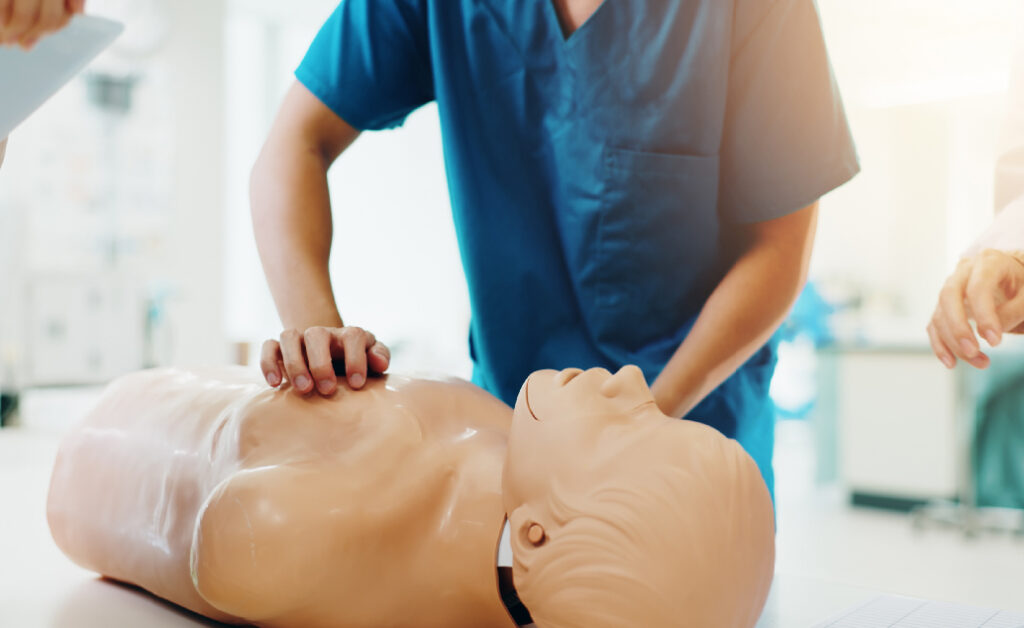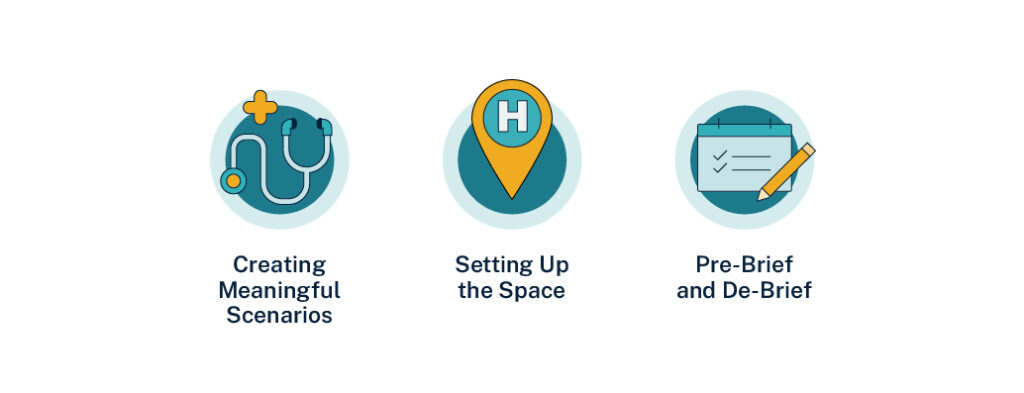
Healthcare simulation, sometimes referred to as clinical simulation, is a hands-on training tool for healthcare professionals to practice and gain confidence in patient care. Real-world scenarios are “simulated” with different elements that represent equipment use, problem-solving and operational processes.
Using simulation to educate healthcare staff has become an exceedingly popular and effective form of employee training. The cost to access simulation equipment, space and technology seem like a barrier for meaningful training events, but it doesn’t have to be. Let’s discuss ways to create innovative, budget-friendly training.
Benefits of Simulation in Healthcare Education
Simulation in healthcare grew significantly after the pandemic, especially virtual simulation tools. Lockdown forced us to find new ways to train healthcare professionals, but the years since have proven the invaluable benefits of simulation. It’s now a medical education powerhouse that equips newly employed nurses in training and even those who are still working toward the education and training needed to become a nurse.
Simulation-based education and training creates safe learning opportunities and environments that foster interdisciplinary relationships, instill confidence and build trust. It also develops the clinical skills that contribute to positive patient outcomes in clinical practice.
Simulation in ACE Nursing Programs
Colleges including American College of Education who offer fully online learning often lean on virtual forms of simulation to give students the benefits of simulation-based learning in a flexible and accessible way. This is especially common in their nursing programs: RN to BSN, RN to MSN and BSN to MSN.

How to Create Low-Cost Simulation Training
Healthcare educators dream of a fully stocked simulation lab, but not having one doesn’t mean you can’t develop unique learning experiences. The recipe for successful, budget-friendly simulation takes a bit of creativity and a great deal of planning. The good news, however, is that it’s doable and equally as effective as higher-cost options. Let’s walk through how you can bring affordable simulation to your healthcare education plan!
Creating Meaningful Scenarios
As a clinical manager and nurse educator, I put myself in the trainees’ shoes during curriculum development and building scenarios by asking myself, what is the answer I am looking for?
Create case scenarios by first establishing learning objectives for trainees. What do you want them to accomplish? Do you want them to engage critical thinking in a deterioration scenario, assess knowledge retention of a treatment protocol, or demonstrate hands-on skills?
When possible, pull from experience. Choose a real-life scenario as the base of your story to keep the experience relatable. A good case scenario is not one dimensional. The learner should be able to move through it with a variety of responses and still meet the intended learning objectives. It never hurts to phone a friend when creating dynamic case scenarios. Tap into experts to ensure the scenario closely follows real-world situations.
Pro tip: Take the case scenario on a test run by talking through it with fellow clinicians. See where they take the adventure and ask them to think as a novice would. The more you test the scenario, the more you can include components that allow the learner to personalize the experience.
Setting Up the Space
Set up simulation in an unused patient room. If this isn’t an option, you can also transform a conference room or old closet space. Start with creating a list of items needed from the case scenario: If the participant needs to see it or touch it, then the item should be on the list. The more attention to detail the better. The participant is more likely to fully embrace the experience if the set-up represents actual work environments.
High fidelity mannequins can be replaced with amateur actors like your colleagues. In lieu of actors, low fidelity mannequins and even a CPR chest can be turned into a practice patient. Put the donation pile to clever use and dress the patient. Stuffing long sleeved shirts and pants with linens makes for a suitable fake body and one you can even put needles in. If your scenario includes a small child or infant, baby dolls make simple stand-ins.
If a bed is not available, then a stretcher or even a table can substitute for a hospital bed. Suction and oxygen brackets can be easily mounted to a small piece of wood or foam poster board. Attach them and any other needed items to the walls of your makeshift room using command hooks.
Gather poles, pumps, bedside tables and rolling cabinets that aren’t in use. When furniture is updated in the hospital, you can claim the old items for your simulation room.
Utilize old and expired supplies, equipment or medications. Be sure to keep expired medications away from patient care areas and label them as “not for patient use.” Alternatively, fake medication labels can be created through pictures, digital programs and photoshop. Affix labels to syringes or old saline bags to give the learner a more realistic experience.
Lastly, walk the room. Think about how the learner might engage with the space to add finishing details. If you’re using a large conference room, you can create multiple spaces. By dividing the space with tape as floor markings, the participant can simulate the act of walking out of the room or calling for help at a nurse station.
Pre-Brief and De-Brief
The pre-brief is just as important as the simulation. Establish a safe learning environment where employees can learn away from direct patient care where mistakes turn into growth opportunities. Share the purpose of the event, expectations for engaging and the value of the experience. During this time, orientate the participant to the simulation space and allow them to ask clarifying questions.
The debrief ties the experience together and gives the participant time to reflect on how they feel and what they learned. The debrief solicits the participant’s perspective. As a facilitator, use the feedback to guide the learning experience and assure objectives are met.
A former colleague of mine used to always say, “Practice like you play.” Nothing can be truer when considering healthcare simulation. Practice creates muscle memory and emulating relatable scenarios improves confidence in real-life situations which ultimately improves patient safety and outcomes through confident, knowledgeable clinicians.
Become a healthcare educator equipped to lead tomorrow’s generation of healthcare professionals with the healthcare programs at American College of Education.

